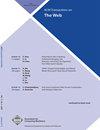GroupAligner: A Deep Reinforcement Learning with Domain Adaptation for Social Group Alignment
IF 4.1
4区 计算机科学
Q2 COMPUTER SCIENCE, INFORMATION SYSTEMS
引用次数: 0
Abstract
Social network alignment, which aims to uncover the correspondence across different social networks, shows fundamental importance in a wide spectrum of applications such as cross-domain recommendation and information propagation. In the literature, the vast majority of the existing studies focus on the social network alignment at user level. In practice, the user-level alignment usually relies on abundant personal information and high-quality supervision, which is expensive and even impossible in the real-world scenario. Alternatively, we propose to study the problem of social group alignment across different social networks, focusing on the interests of social groups rather than personal information. However, social group alignment is non-trivial and faces significant challenges in both (i) feature inconsistency across different social networks and (ii) group discovery within a social network. To bridge this gap, we present a novel GroupAligner, a deep reinforcement learning with domain adaptation for social group alignment. In GroupAligner, to address the first issue, we propose the cycle domain adaptation approach with the Wasserstein distance to transfer the knowledge from the source social network, aligning the feature space of social networks in the distribution level. To address the second issue, we model the group discovery as a sequential decision process with reinforcement learning in which the policy is parameterized by a proposed proximity-enhanced Graph Neural Network (pGNN) and a GNN-based discriminator to score the reward. Finally, we utilize pre-training and teacher forcing to stabilize the learning process of GroupAligner. Extensive experiments on several real-world datasets are conducted to evaluate GroupAligner, and experimental results show that GroupAligner outperforms the alternative methods for social group alignment.GroupAligner:一种基于领域自适应的深度强化学习方法
社交网络比对旨在揭示不同社交网络之间的对应关系,在跨领域推荐和信息传播等广泛应用中显示出根本重要性。在文献中,现有的绝大多数研究都集中在用户层面的社交网络对齐。在实践中,用户级别的对齐通常依赖于丰富的个人信息和高质量的监督,这在现实世界中是昂贵的,甚至是不可能的。或者,我们建议研究不同社交网络中的社会群体结盟问题,重点关注社会群体的利益,而不是个人信息。然而,社交群体对齐是不平凡的,并且在(i)不同社交网络之间的特征不一致性和(ii)社交网络内的群体发现方面都面临着重大挑战。为了弥补这一差距,我们提出了一种新的群体对齐器,这是一种具有领域自适应的深度强化学习,用于社会群体对齐。在GroupAligner中,为了解决第一个问题,我们提出了具有Wasserstein距离的循环域自适应方法,以转移来自源社交网络的知识,在分布级别上调整社交网络的特征空间。为了解决第二个问题,我们将群体发现建模为具有强化学习的顺序决策过程,其中通过所提出的邻近增强图神经网络(pGNN)和基于GNN的鉴别器来参数化策略,以对奖励进行评分。最后,我们利用预先培训和教师强制来稳定GroupAlign的学习过程。在几个真实世界的数据集上进行了广泛的实验来评估GroupAlign,实验结果表明,GroupAlign在社会群体对齐方面优于其他方法。
本文章由计算机程序翻译,如有差异,请以英文原文为准。
求助全文
约1分钟内获得全文
求助全文
来源期刊

ACM Transactions on the Web
工程技术-计算机:软件工程
CiteScore
4.90
自引率
0.00%
发文量
26
审稿时长
7.5 months
期刊介绍:
Transactions on the Web (TWEB) is a journal publishing refereed articles reporting the results of research on Web content, applications, use, and related enabling technologies. Topics in the scope of TWEB include but are not limited to the following: Browsers and Web Interfaces; Electronic Commerce; Electronic Publishing; Hypertext and Hypermedia; Semantic Web; Web Engineering; Web Services; and Service-Oriented Computing XML.
In addition, papers addressing the intersection of the following broader technologies with the Web are also in scope: Accessibility; Business Services Education; Knowledge Management and Representation; Mobility and pervasive computing; Performance and scalability; Recommender systems; Searching, Indexing, Classification, Retrieval and Querying, Data Mining and Analysis; Security and Privacy; and User Interfaces.
Papers discussing specific Web technologies, applications, content generation and management and use are within scope. Also, papers describing novel applications of the web as well as papers on the underlying technologies are welcome.
 求助内容:
求助内容: 应助结果提醒方式:
应助结果提醒方式:


